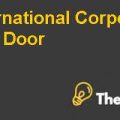
Starbucks Canada: Mobile Payment Decision Case Solution
Background of the company
Starbucks café was founded by three friends to sell high quality coffee with a new roasting technique in Pike Palace, Settle in the year 1971. It was later purchased by a former employee, Howard Schultz, at the café in 1987. Howard focused on the rapid expansion of the café both nationally and globally(Drinks, n.d).
Starbucks Canada was established in 1987 as the first international location at Sea bus Sky train Station in Vancouver. It also expanded rapidly in the short period of time, resulting in the incorporation of the Starbucks Coffee Canada and became a subsidiary of the Starbucks U.S Company. It resulted in more autonomy for the Canadian division and decision making was done on the geographical division levels. It was allowed make decision for its self at the function level including store development and design, marketing and Channel development. It also meant that it could also make decisions regarding CRM,Starbucks card, and ecommerce. The autonomy proved to be beneficial for the division and it was able to expand to 1,350 locations by December, 2013.
The ideology behind the expansion was to become a “Third Place” or a connecting place between home and work to provide people with a place to socialise and relax for hours. Howard’s vision was to make Starbucks a place to connect, which also led to the introduction of customizable drinks and services (with name on coffee cups). Overall, the company was trying to more customers oriented and be able to provide customer centric experience(CJ Thompson, 2004).
It was recently reported by some of the customers that the “third place” vision has been fading away. It was also indicated that it is now less suitable for long visits and included smaller tables and louder music to accommodate more customers. The prolonged laptop usage was restricted by covering the power outlets at some locations as well. It started to seem that the company has been shifting from its original vision and values it highly regarded(C Pastoll, 2014).
Key Issues
Issues identification
The company is facing following problems which are to be addressed efficiently and effectively by the top management of the company.
Primary Issues
PAYMENT STRUCTURE:
There are a number of issues with the payment structure of the company. The company is unable to receive payments from its customers efficiently and effectively, which poses a negative impact on the overall profitability of the company. Currently the company is considering implementing mobile payments in its 1350 locations across Canada.
. Thus, this also affects negatively on the overall business interest of the company as well as this also limits the overall profitability of the company(A Saunders, 2006).
LACK OF MAKING EFFECTIVE PAYMENT NETWORK:
The management of the company is unable to identify and formulate the effective payment structures which could allow the company to enhance its overall payment structure as well as which could also allow the company to enhance its profitability.
UNABLE TO IDENTIFY THE OPTIMAL TECHNOLOGY:
The management of the company is unable to identify the potential and optimal technologies which could allow the company to enhance its overall efficiency of the payment structure as well as which could also allow the company to integrate the mobile payment system across its locations all over Canada efficiently and effectively.
MANGERIAL COMPLEXITIES:
The top management of the company is unable to manage the wide spread operations of the company efficiently and effectively due to which the overall efficiency of the operations of the company is compromised.........................
This is just a sample partial case solution. Please place the order on the website to order your own originally done case solution.













